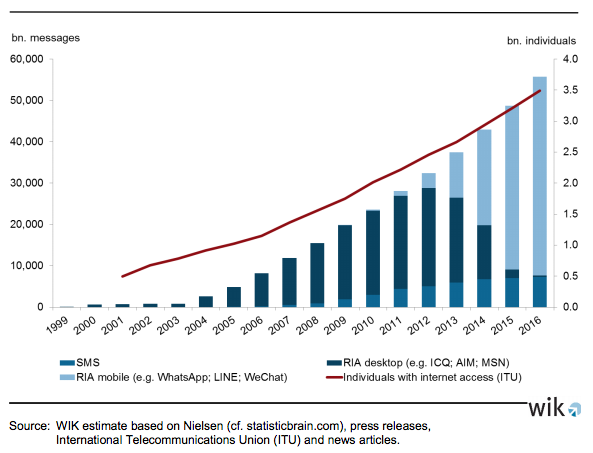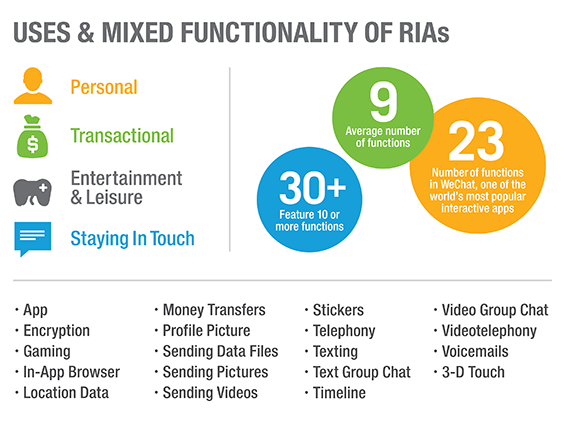What Do WhatsApp and AIM Have in Common?
This is part of a series of posts on the impact of Rich Interaction Applications (RIAs).
Rich interaction applications (RIAs) are constantly evolving, employing new features and functionalities, and new ones are popping up everyday. For example, DisCo recently explained how Zelle, a new person-to-person (P2P) payments network, could challenge Venmo, which has been a P2P leader, processing $6.8 billion in payments in Q1 2017 (up 114% from 2016). That post pointed out a key difference though:
In addition to its obviously large user base, Venmo may also have something Zelle (currently) does not: a social component. Dan Schulman, the CEO of PayPal (which acquired Venmo in 2013), regards this social component as crucial to Venmo’s success.
Venmo has been able to distinguish itself because it facilitates interactions between users. If I want to pay back a friend for pizza or beer, Venmo lets me comment on my transaction by entering text or emojis like ‘??? ’ explaining what the transaction was for. Venmo has focused on making a payment transferring money from one account to another more of a social experience.
Venmo and other RIAs offer lots of different functions, and they keep adding new ones. WIK recently studied 139 different RIAs and found that RIAs feature an average of nine functions with WeChat providing the most — 23. They provide a wide range of opportunities for interaction.
RIAs keep evolving, too. WhatsApp launched in early 2009, it initially focused on allowing users to post status updates. When Apple rolled out push notifications in June 2009, WhatsApp’s founders used this to announce when users had changed their statuses, and, as Alex Fishman, a friend of WhatsApp’s founders, said, “At some point it sort of became instant messaging.” Soon, WhatsApp began adding features like group chats (February 2011), browser-based use (January 2015), voice calls (June 2015), end-to-end encryption (April 2016), and video calls (November 2016). WeChat was introduced two years after WhatsApp and offers a wide range of functions (23 – the most recorded by WIK), including text messaging, voice and video calls, in-app video gaming, translation, money transfers, location sharing, and 3D touch.
Adding new features is crucial to the success of RIAs and has led to fierce competition. WhatsApp’s and WeChat’s rapid adoption of new features has led them to about 1.2 billion and 938 million monthly active users, respectively. Because most RIAs feature Internet-based architecture, they can add new functions quickly and also integrate with other applications.
The Predecessors of Today’s RIAs
Though many RIAs feature text messaging and voice call capabilities, they actually trace their origins back to the earliest desktop-based interactive applications like MIT’s Compatible Time-Sharing System (CTSS); the Zephyr Notification System; and the SDC time-sharing system. One of the most famous, early RIAs was AOL Instant Messenger (AIM). AIM was introduced in 1997 and was a driver of AOL’s success in the dial-up Internet era. According to Mashable, AIM developed from the buddy list, which would tell you when other users were also online. Even though they did not have formal approval from AOL higher-ups, AIM’s developers soon added a messaging capability and quickly found that they had to create their own code and find their own servers for the project. Competitors like MSN Messenger and Yahoo! Messenger sought to get in on the action, which led to a fierce chat war in the late ‘90s and early 2000s.
As AOL changed from an hourly to a flat fee structure and more and more users stayed online for longer periods, AIM quickly attracted 18 million simultaneous users. AIM became notable for letting users create customized screen names and profiles, users could leave away messages and provide links to websites, and users could incorporate different colors, fonts, and other effects in their IMs, too. AIM users popularized slang like LOL, ROFL, OMG, WTF, gtg/g2g, BRB, and emoticons ;). AIM even had advanced features and functionality that are similar to today’s RIAs: voice chat (added before Skype); file transfers; the ability to communicate with cell phones. However, AOL’s executives were not supportive of AIM, and they never found a way to monetize it effectively. Much ink has been spilled about AOL’s business trajectory, but AIM’s legacy lives on as a precursor to many of the RIAs that are so popular today.
RIAs Are Not Traditional Telecommunications Services
The prevalence of text and voice call functionality in RIAs also leads to a common misconception linking RIAs to traditional telecommunications services. The most common RIA functions are sending pictures and texting, and a third of RIAs offer group chats with live audio and/or video. Yet, there are key differences between RIAs and telecommunications services.
The number of messages sent via RIAs has increased significantly compared to SMS (short message service). WIK found, depicted in the chart below, that not only has the number of RIA messages sent annually worldwide exploded since 2011, but that the number of SMS messages has held steady over the past few years.

The steady growth of SMS messages is closely related to the number of subscribers to mobile services. However, the number of worldwide RIA messages, which is creating a huge delta, is closely related to the red line on the graph: the number of people with Internet access.
Unlike the original SMS, which developed from radio telegraphy, RIAs — even the earliest desktop versions — have generally always used IP. Unlike voice calls on the Public Switched Telephone Networks (PSTN), which required interoperability between networks for calls to go through, RIAs were not originally interoperable. For example, a key part of the AIM-MSN Messenger chat war was whether users could connect to the other networks based on different versions of their respective programs. Yet, because early RIAs were IP-based, they did not have the limitations of physical telecommunications networks. Instead, interoperability became driven by market forces and whether it benefitted an RIA developer and its users to connect to other RIAs. Many are now incorporating the services of third parties, like hailing an Uber from Facebook Messenger. Still, some RIA developers prefer to stay independent of others so they can continue developing new features to compete.
Moreover, RIAs are not exclusive to mobile devices. 25 out of the 139 studied were not available in an app, and 68% of the RIAs studied do not have a browser version.
RIAs are also different from telecommunications services because, increasingly, RIAs can function with or without broadband access. In addition to connecting to a user’s in-home Wi-Fi network or one from a coffee shop, RIAs can also utilize existing Bluetooth or Wi-Fi hardware in smartphones to create peer-to-peer networks that do not require traditional network infrastructure. This capability can be especially vital during disasters when fixed or wireless networks can’t provide service.
With the number of functions continuing to evolve, the use of RIAs has become more akin to the use of the Internet in general. RIAs have benefitted from the ability to develop and respond to market forces — not regulatory mandates. Their overwhelming economic impact — $5.6 trillion impact on GDP for every 10% increase in the global usage — will continue as long as governments do not seek to impose unnecessary burdens or regulations that do not fit with the wide variety of functions or historical origins of RIAs.









